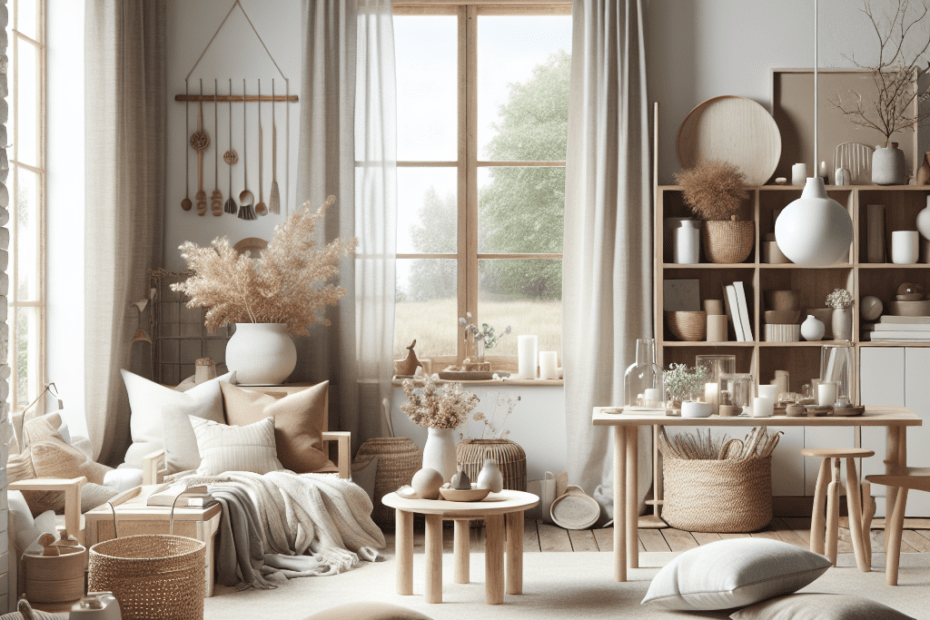“`html
The Essentials of Scandinavian Rustic Design
When people think of Scandinavian design, they often picture clean lines, minimalist aesthetics, and functional beauty. However, an emerging trend is the blend of this classic style with rustic elements, creating a warm and inviting atmosphere without losing the simplicity that Scandinavian design is known for. This style, aptly named Scandinavian Rustic Design, emphasizes comfort, natural materials, and a cohesive blend of old-world charm infused into modern simplicity.
The Core Principles
Scandinavian Rustic Design revolves around a few core principles that make it both distinctive and universally appealing. These principles include simplicity, functionality, and charm, with a focus on nature.
- Simplicity: True to its roots, this design prioritizes delicate and uncomplicated elements, employing neutral colors such as whites, grays, and beiges to form a tranquil environment.
- Functionality: Every decor item has a purpose, helping to maintain a clutter-free space. Storage solutions are cleverly hidden in plain sight, allowing spaces to remain spacious and breezy.
- Natural Materials: The rustic element is enhanced with raw wood, stone, wool, and other materials that bring a warm, earthy appeal.
Why the Trend Gained Popularity
Recent studies have shown an increasing desire for sustainable and eco-friendly home solutions. According to a report by Statista, about 57% of participants expressed that sustainability was a factor when making decisions about home designs. In Scandinavian Rustic Design, sustainability is seamlessly woven into the aesthetic, making it a perfect choice for the eco-conscious homeowner.
Incorporating Colors and Textures
The Scandinavian Rustic style embraces natural hues and textures. Walls are usually painted in soft whites or muted grays, ensuring a perfect backdrop for rustic furniture and decor. Integrating texture is key. Consideration is given to materials like reclaimed wood tables, stone kitchen islands, and linen drapes. These textures add depth and contribute to the layered, cozy feel that the style aims to create.
The Furniture and Decor
Whenever possible, they choose furniture that tells a story. Vintage or handcrafted pieces are favored, bringing character with a hint of nostalgia. Furniture often highlights the natural grain of wood, celebrating the imperfections as unique beauty markers. Accessories are usually practical, like a throw blanket providing warmth and aesthetic. Minimalism doesn’t equate to sterility in this design; instead, it showcases familiar comfort and livability.
| Element | Characteristic |
|---|---|
| Wall Colors | Soft whites, muted grays |
| Furniture | Reclaimed wood, vintage |
| Textures | Natural grain, linen, stone |
Lighting: A Crucial Element
In a region where winters can be long and dark, lighting plays an essential role. They utilize a combination of natural light, when available, with carefully selected artificial lighting. Light fixtures in the Scandinavian Rustic Design tend to be simple yet bold, often featuring metal and wood combinations. Candles are also commonly used, enhancing the warm ambiance.
Bringing the Outdoors In
Nature is ever-present, not just in the materials but also in the decor. They might incorporate plants into their designs, which add color and life to the neutral palettes. The connection with nature is also fostered through open spaces, large windows, and transitional areas that blur the line between indoors and outdoors.
Key Takeaways
- Scandinavian Rustic Design balances simplicity, functionality, and nature.
- Sustainable materials and thoughtful designs resonate well with eco-friendly trends.
- Neutral colors and natural textures play a significant role.
- Lighting is crucial, and outdoor elements are incorporated into decor.
FAQ
- What sets Scandinavian Rustic Design apart from usual rustic designs?
It blends clean and minimalist Scandinavian principles with cozy, natural elements of rustic design.
- What kind of materials are most commonly used?
Natural materials like wood, stone, and wool are imperative to Scandinavian Rustic Design.
- Is it important for the elements to be sustainable?
Yes, sustainability is a significant aspect that aligns with modern eco-friendly lifestyle choices.
- How does this design deal with lighting?
It combines natural lighting with simple yet striking fixtures, often incorporating candles for warmth.
- Can Scandinavian Rustic Design be incorporated in small spaces?
Absolutely. Its minimalistic approach and clever use of space make it ideal for smaller areas.
“`
This source provides a basic understanding of Scandinavian Rustic Design, suitable for readers looking to integrate this style into their own home. The article covers key elements, popularity, and practical tips, ensuring a comprehensive overview of the topic.
